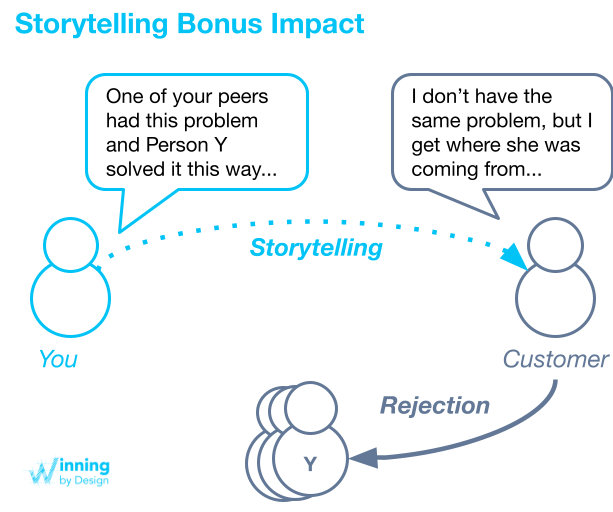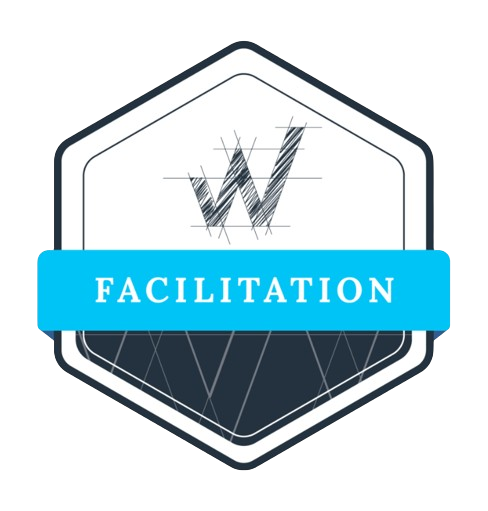One of the most powerful sales skills you can master is storytelling.
When you share how you helped someone with similar challenges, you are more persuasive than just telling them you can help. A story helps plant an idea that can change their mind or open them up to new possibilities.
The Science of Storytelling
The brain actively participates when hearing a story in 4 ways:
- Dopamine: The brain releases this neurotransmitter after experiencing an emotionally-charged event – making it easier to remember key facts with greater accuracy.
- Neural Coupling: A story activates parts of your brain to allow the listener to convert the story into their own ideas and experience.
- Syncing: Listeners will have similar brain activity to others hearing the story and also the storyteller.
- Cortex Activation: When processing facts, two areas of the brain are activated (Broca’s and Wernicke’s area). A great story can engage other areas like the sensory, frontal and motor cortex.

Figure 1: Visualized 3-Part Storytelling Framework for SaaS Sales
Hero’s Journey Simplified – The 1-minute Story
Every great story follows a well defined framework. We don’t need a complex movie plotline (Pixar famously has 12 Acts), but there does need to be a beginning, middle and the end.
In sales as in life, simpler is better than complex. Distill the most important elements of your story into as few words as possible while still getting the desired impact. Aim to have 1-2 sentences max for each part.
Part 1: Beginning – Make it Personal
The purpose of the opening is to set context to help your customer connect to the main character of your story. Make it relatable. When sharing customer’s stories to a prospect, don’t just say your customer’s company name, e.g. Microsoft.
Describe a similar person at their company to the person you’re talking to by name, title and other relevant details. This could be industry (retail, security), size (500, 5,000 and 50,000 employee companies have significantly different challenges), location (Global vs. 1 office HQ).
Be careful to not turn your story into gossip – don’t give enough personal details that your listener can look up the person on the internet – but don’t make it so generic it sounds like you are making up random information.
Too Impersonal |
Connect the Listener to Your Customer |
That reminds me of one of our customers, Microsoft, had a similar problem… |
That reminds me of Jill, who like you is the VP of Product at a public company based in Washington. |
Part 2: Middle – Describe the Pain and Negative Impact
Take your customer down the roller-coaster before describing the positive outcome. Explain the challenges they had, and describe the negative impact associated. Too often, we don’t build enough drama between the pain and the solution because we don’t want anyone to feel bad.
This shortcut makes for a mediocre story. Instead, paint a picture of the challenges they were having, and the negative impact that would happen to their business if they didn’t solve those challenges.
Shortcut – Too Little Pain |
Describe the Negative Impact |
They struggled with knowing which products to focus on for their customers so they… |
She had no visibility into the data of what features customers were requesting. This led her team to build the wrong product and waste 3 months of time. |
Part 3: End – The Solution and Positive Impact
Your customer is the “Hero” in the story you’re describing, not your own company.
Your ending needs to leave an impression that your company assisted the customer like Yoda assisted Luke Skywalker or Dumbledore assisted Harry Potter. Describe how your customer thrived after solving this problem.
When you say “After using my company Acme,…”- then your story just feels like a sales pitch. Instead make it about the type of solution you helped provide to build intrigue and neural coupling to their own experience.
Avoid Pitching |
Your Customer is the Hero |
After using my company Acme, they were able to see make a lot more money. |
After integrating a digital feedback system into their workflow, Jill’s team was able to prioritize the most important feature to create which resulted in driving revenue up 30%. Would that be relevant to you? |
When done correctly, your prospect will ask you “That’s exactly what I’m looking for, how did Jill achieve that?” to which the answer is of course your solution.
But wait – there’s more
Not only does storytelling help customers connect their pain with your solution more effectively than pitching- but if you happen to tell a story that’s not relevant, they reject the customer in your story, not you!
3rd Party Reference – Bonus Impact
Using case-studies as a third party reference drastically helps your storytelling. In the example below, you notice the hard pitch – followed by the rejection. This can put a quick stop to a conversation.

Figure 2: Sales Centric Pitching vs. Storytelling Can Lead to Rejection
When you use a 3rd party reference, you talk through: who experienced the problem (person not just the company name), what was the problem they experienced (in context), what was the impact they got from it.

Example Story:
Bobbi was a new VP of Sales of a global sales team of 30. She had recently hired a team of 6 new SDRs. She wanted them to be the world’s best SDRs, but found that she didn’t have as much time as she needed to effectively coach and onboard the new team. She found that ramp times took longer than expected, and preventable mistakes were causing customers to be disqualified and lost opportunities.
After implementing a learning platform with defined frameworks and previously recorded training sessions,, she could spend her coaching time with her team applying the concepts through practice instead of teaching.
After implementing this training program, Bobbi noticed improvements across the board: the number of SQLs went up – and the opportunities closed faster, and her team was onboarded 26 days faster than before. Is that relevant to you?
Conclusion
Storytelling is a skill that can be practiced. Great stories help the listener connect and remember details more accurately. Storytelling for SaaS sales is one of the most powerful techniques to influence and help your customer solve their problem.

